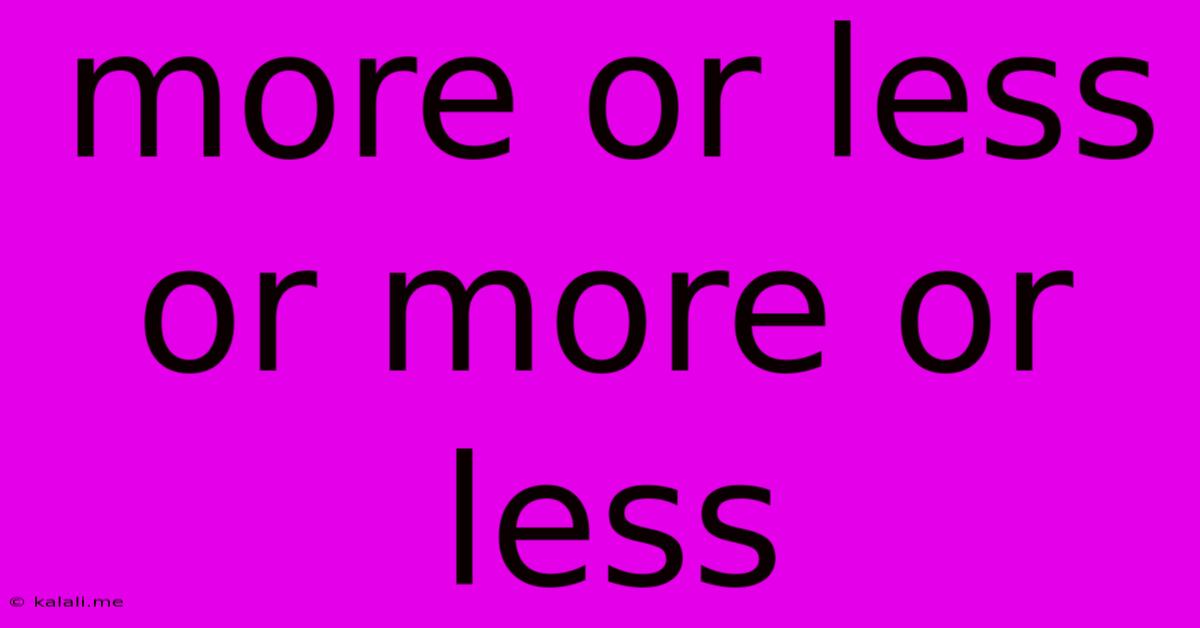More Or Less Or More Or Less
Kalali
May 25, 2025 · 3 min read

Table of Contents
More or Less: Decoding the Ambiguity of a Common Phrase
This article explores the meaning and usage of the phrase "more or less," examining its nuances and offering guidance on its appropriate application in writing and conversation. The phrase, seemingly simple, carries a degree of ambiguity that can be easily misunderstood if not carefully considered. Understanding its subtleties enhances clarity and precision in communication.
What does "more or less" actually mean?
At its core, "more or less" is an adverbial phrase indicating approximation. It suggests that a statement is not entirely precise but conveys a general idea. It implies a degree of uncertainty or imprecision, hinting at a range rather than an exact figure. Think of it as a softer, less definitive way of saying "approximately" or "around."
Different Contexts, Different Interpretations:
The meaning of "more or less" can subtly shift depending on the context. Here are some key ways it's used:
-
Approximation of Quantity: "I have more or less 100 books." This means the speaker likely has a number close to 100, perhaps slightly more or slightly fewer. The exact number isn't critical.
-
Approximation of Time: "The meeting will start more or less at 2 pm." This suggests a slight flexibility in the starting time. The meeting might begin a few minutes before or after 2 pm.
-
Approximation of Quality or Degree: "He's more or less happy with his job." This indicates a level of contentment, but not complete satisfaction or dissatisfaction. It suggests a middle ground.
-
Expressing Uncertainty: "More or less, that's the story." This usage conveys a lack of complete certainty about the accuracy or completeness of the information.
Using "More or Less" Effectively:
While useful for conveying approximate information, overuse can lead to vagueness. Strive for balance. Consider these points:
-
Specificity when Necessary: In situations demanding precision, avoid "more or less." Scientific reports, legal documents, and financial statements require exact figures.
-
Audience Consideration: The appropriateness of using "more or less" depends on your audience. Formal settings might require more precise language.
-
Alternative Phrases: Consider using more specific alternatives when possible, such as "approximately," "around," "roughly," "about," or "nearly." This demonstrates greater care and attention to detail.
-
Context is Key: The meaning of the phrase is greatly influenced by the surrounding words and the overall tone of the conversation or writing.
Examples of "More or Less" in Context:
-
Precise: "The experiment yielded exactly 12.5 grams of product."
-
Approximate: "The experiment yielded more or less 12.5 grams of product."
-
Precise: "The deadline is 5 PM on Friday."
-
Approximate: "The deadline is more or less 5 PM on Friday."
-
Precise: "He completely finished the project."
-
Approximate: "He more or less finished the project."
Conclusion:
"More or less" is a convenient phrase for conveying approximation, but its imprecise nature requires careful consideration. Understanding its nuances and employing it judiciously ensures clear and effective communication. Choosing more precise alternatives when accuracy is crucial is key to responsible writing and speaking. Remember to always consider your audience and the overall context before using this phrase.
Latest Posts
Latest Posts
-
How To Fix Curtain Rod Pulled Out Of Wall
May 25, 2025
-
How Did Gatsby Earn His Money
May 25, 2025
-
Ora 01102 Cannot Mount Database In Exclusive Mode
May 25, 2025
-
What Number Comes Next In The Sequence
May 25, 2025
-
How To Fix Exhaust Leak At Flange
May 25, 2025
Related Post
Thank you for visiting our website which covers about More Or Less Or More Or Less . We hope the information provided has been useful to you. Feel free to contact us if you have any questions or need further assistance. See you next time and don't miss to bookmark.